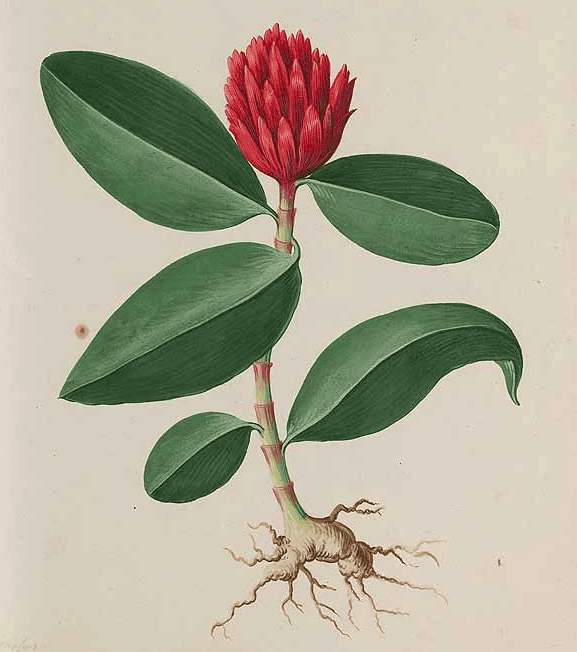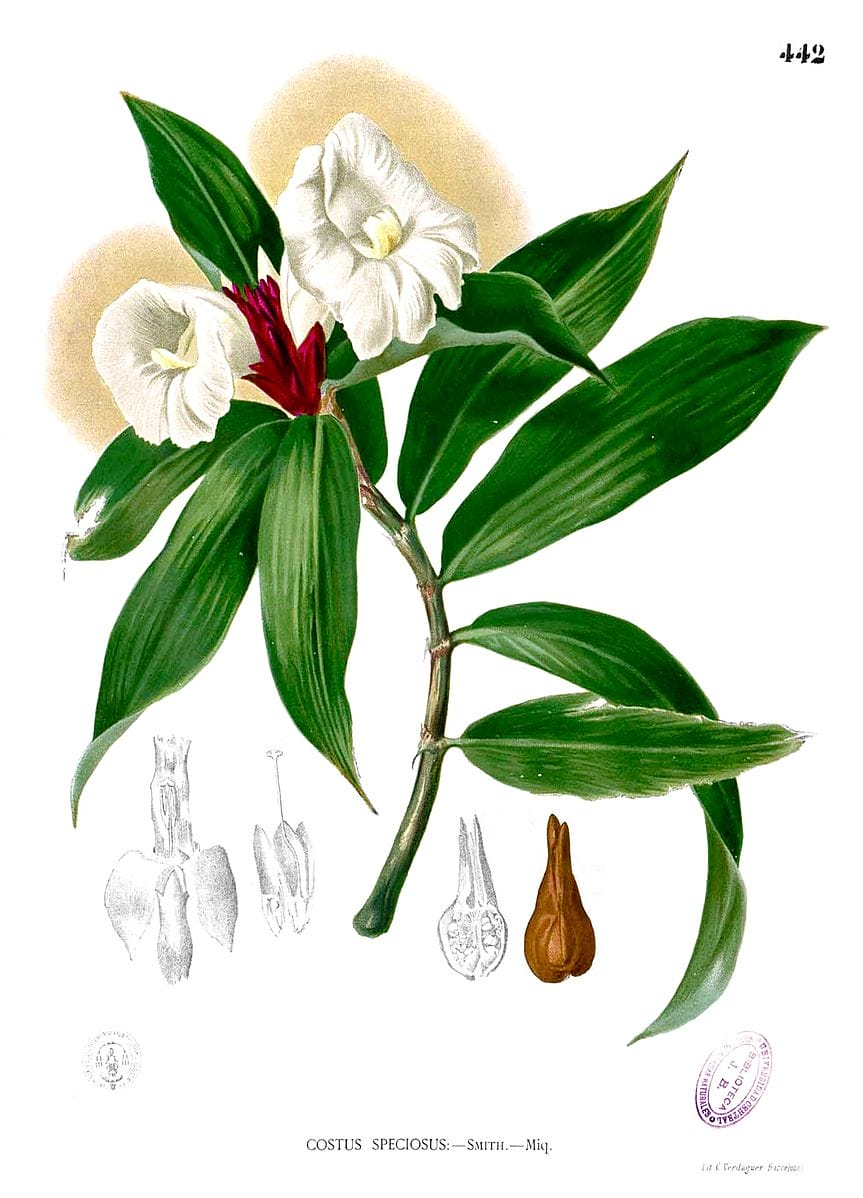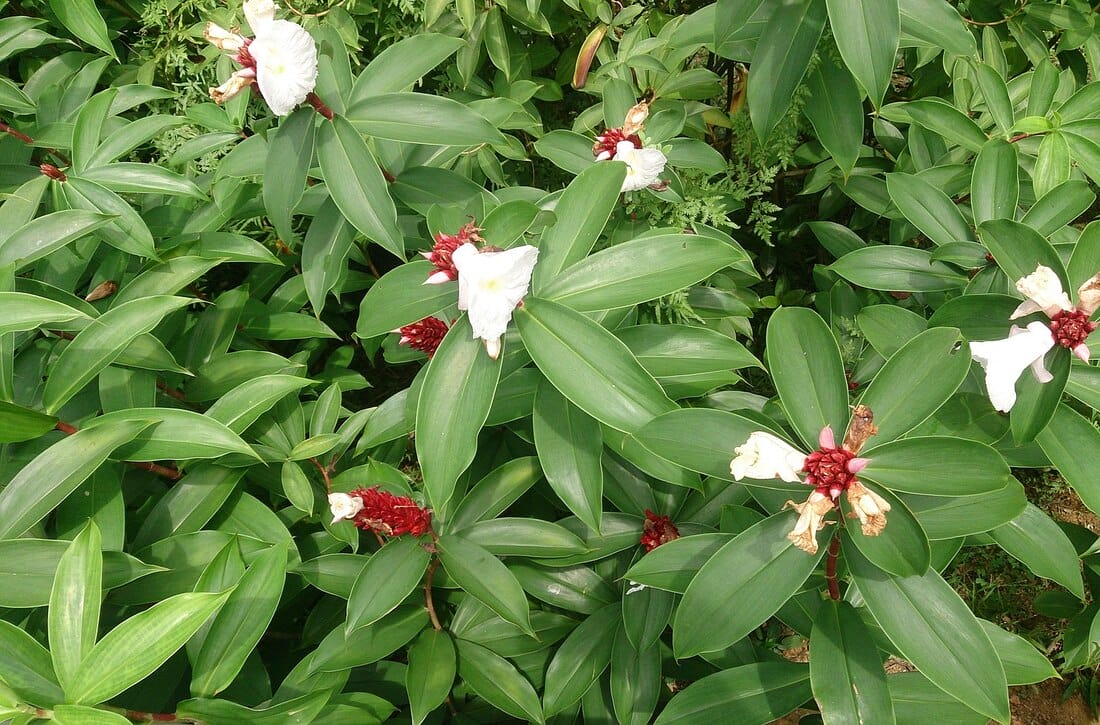Costus speciosus, Push kar mu la
Wild Ginger, Crepe GingerPush kar mu la (Tibetan)
Kebuka (Ayurveda) (sometimes called Kustha)
Zhang Liu Tou (TCM)
 Costus speciosus
Costus speciosusN. Witsen, H. de Jager, Plantae Javanicae pictae, ex Java transmissae anno MDCC, (1700)
 Costus speciosus
Costus speciosusBlanco, Flora de Filipinas. (1875)
 Costus speciosus
Costus speciosus(Photo by Mokkie) (Wikimedia)
Botanical name:
Costus speciosus (syn. Banksia speciosus, Cheilocostus speciosus)
Parts used:
Root, rhizome
Temperature & Taste:
Warm, dry. Pungent
Uses:
1. Clears Phlegm, Stops Cough:
-Cough, Bronchitis, Asthma
2. Clears Damp, Promotes Urine, Stops Pain:
-Gout, Rheumatism, Osteoarthritis
-Edema, Fluid Swellings, Ascites
-Dysuria, Jaundice
3. Resists Poison, Resolves Swellings:
-Fever, Colds, Influenza
-Welling Abscess, Carbuncles, Boils
-Skin diseases including Leprosy
-Snake Bite, Dog Bites, Food Poisoning,
4. Moves the Blood, Stops Bleeding:
-retention of the Placenta; contracts Uterus
-Postpartum Bleeding
-Threatened Miscarriage
-Hemorrhoids
-Bradycardia
5. Astringes to Stop Leakage:
-Diabetes
-Spermatorrhea, Seminal Emission
6. Externally:
-herbs is applied as a paste to fluid swellings
-Ear infection, the juice is instilled in the ear
-applied to skin diseases
Dose:
Prepared root: 3–6 grams
For Worms, 2 spoonfuls of the root juice has been used.
A spoonful of the powder has been taken for Constipation
Comment:
1. Should not be confused with Costus root, Saussurea lappa. Numerous sources have listed C. speciosus as a source for Ru rta, the ‘true’ Costus, Saussurea lappa. it is uncertain if, perhaps, the root has been used as a substitute for Costus.
2. Pushkamula is Inula racemosa in Ayurveda. It would appear this is one of the Tibetan names derived from Ayurvedic sources. The fact that Inula and Saussurea species are closely related and are often viewed as different types of the same medicine (ie. Sweet and Bitter Costus in the West) suggests that maybe C. speciosus has been used as a synonym or source for Costus in the past.
Main Combinations:
Major Formulas:
Cautions:
1. Use cautiously during Pregnancy. It is strongly ecbolic but has been used for Threatened Miscarriage.
Main Preparations used:
ANTI-BACTERIAL:
–Phytochemical, Histochemical and In Vitro Antimicrobial Study of Various Solvent Extracts of Costus speciosus (J. Koenig) Sm. and Costus pictus D. Don.
–Antimicrobial, antiquorum sensing, and antiproliferative activities of sesquiterpenes from Costus speciosus rhizomes.
–Antimicrobial activity of sesquiterpene lactones isolated from traditional medicinal plant, Costus speciosus (Koen ex.Retz.) Sm.
–Cytotoxic and antibacterial activities of endophytic fungi isolated from plants at the National Park, Pahang, Malaysia.
ANTI-VIRAL:
INFLUENZA:
–The Aqueous Leaf Extract of the Medicinal Herb Costus speciosus Suppresses Influenza A H1N1 Viral Activity under In Vitro and In Vivo Conditions.
COVID:
–The dual role of phytochemicals on SARS-CoV-2 inhibition by targeting host and viral proteins.
ANTI-FUNGAL:
–Antimicrobial, antiquorum sensing, and antiproliferative activities of sesquiterpenes from Costus speciosus rhizomes.
–Methyl ester of para-coumaric acid: antifungal principle of the rhizome of Costus speciosus.
ANTIOXIDANT:
–Costus speciosus extract protects against the oxidative damage of zearalenone via modulation of inflammatory cytokines, Nrf2 and iNOS gene expression in rats.
–Antioxidant and antihyperlipidemic activity of Costus speciosus against atherogenic diet-induced hyperlipidemia in rabbits.
–Anti-inflammatory, antioxidant and antiangiogenic activities of diosgenin isolated from traditional medicinal plant, Costus speciosus (Koen ex.Retz.) Sm.
–Antioxidant activity of costunolide and eremanthin isolated from Costus speciosus (Koen ex. Retz) Sm.
–In-vitro Evaluation of Antioxidant Activity and Phenolic Content of Costus speciosus (Koen) J.E. Sm.
–Screening of Costus speciosus extracts for antioxidant activity.
ANTI-INFLAMMATORY:
–Anti-inflammatory, antioxidant and antiangiogenic activities of diosgenin isolated from traditional medicinal plant, Costus speciosus (Koen ex.Retz.) Sm.
–Anti-inflammatory sesquiterpenes from Costus speciosus rhizomes.
–Antiinflammatory, Analgesic and Antipyretic Activities of Aerial Parts of Costus speciosus Koen.
–Anti-inflammatory and antipyretic properties of the rhizome of costus speciosus (koen.) sm.
ANTI-PYRETIC:
Anti-inflammatory sesquiterpenes from Costus speciosus rhizomes.
–Antiinflammatory, Analgesic and Antipyretic Activities of Aerial Parts of Costus speciosus Koen.
–Anti-inflammatory and antipyretic properties of the rhizome of costus speciosus (koen.) sm.
ANTI-NEUROINFLAMMATORY:
–Costunolide inhibits proinflammatory cytokines and iNOS in activated murine BV2 microglia.
ANALGESIC:
–Antiinflammatory, Analgesic and Antipyretic Activities of Aerial Parts of Costus speciosus Koen.
ANTI-NOCICEPTIVE:
–Assessment of anti-nociceptive efficacy of costus speciosus rhizome in swiss albino mice.
ANTI–MYCOTOXIN:
–Costus speciosus extract protects against the oxidative damage of zearalenone via modulation of inflammatory cytokines, Nrf2 and iNOS gene expression in rats.
ANTI-PARASITIC:
–Antiparasitic efficacy of Gracillin and Zingibernsis newsaponin from Costus speciosus (Koen ex. Retz) Sm. against Ichthyophthirius multifiliis.
ACUTE SORE THROAT:
–Evaluating the therapeutic efficacy, tolerability, and safety of an aqueous extract of Costus speciosus rhizome in acute pharyngitis and acute tonsillitis. A pilot study.
TUBERCULOSIS:
–Antituberculosis activity, phytochemical identification of Costus speciosus (J. Koenig) Sm., Cymbopogon citratus (DC. Ex Nees) Stapf., and Tabernaemontana coronaria (L.) Willd. and their effects on the growth kinetics and cellular integrity of Mycobacterium tuberculosis H37Rv.
–Antituberculosis potential of some ethnobotanically selected Malaysian plants.
HYPERLIPIDEMIA:
–Antioxidant and antihyperlipidemic activity of Costus speciosus against atherogenic diet-induced hyperlipidemia in rabbits.
ARTHRITIS:
–Evaluation of anti-arthritic potential of the methanolic extract of the aerial parts of Costus speciosus.
DIABETES:
–Chemical profile and in vivo hypoglycemic effects of Syzygium jambos, Costus speciosus and Tapeinochilos ananassae plant extracts used as diabetes adjuvants in Puerto Rico.
–Molecular mechanisms of anti-hyperglycemic effects of Costus speciosus extract in streptozotocin-induced diabetic rats.
–Use of Complementary and Alternative Medicines (CAMs) among type 2 diabetes patients in Sri Lanka: a cross sectional survey.
–Antidiabetic and antilipidemic effect of eremanthin from Costus speciosus (Koen.)Sm., in STZ-induced diabetic rats.
–Normo-glycemic and hypolipidemic effect of costunolide isolated from Costus speciosus (Koen ex. Retz.)Sm. in streptozotocin-induced diabetic rats.
–Antihyperglycemic and hypolipidemic effects of Costus speciosus in alloxan induced diabetic rats.
–Hypoglycemic effects of three plants from eastern Himalayan belt.
ESTROGENIC:
–Oestrogenic activity of saponins from Costus speciosus (Koen) Sm.
UTERINE CONTRACTIONS:
–The effects of wild ginger (Costus speciosus (Koen) Smith) rhizome extract and diosgenin on rat uterine contractions.
FERTILITY:
–Adverse effect of rheumatoid arthritis on male Wistar rat’s fertility: protective role of Costus extract.
ANTI-FERTILITY:
–Effects of Costus speciosus ethanolic extract on male rats: The action mechanism and the ability to impregnate.
ANTI-ANGIOGENIC:
–Anti-inflammatory, antioxidant and antiangiogenic activities of diosgenin isolated from traditional medicinal plant, Costus speciosus (Koen ex.Retz.) Sm.
ANTI-TUMOR:
–[Research on anti-tumor natural product diosgenin].
CANCER:
–Antimicrobial, antiquorum sensing, and antiproliferative activities of sesquiterpenes from Costus speciosus rhizomes.
–Possible Anticancer Mechanisms of Some Costus speciosus Active Ingredients Concerning Drug Discovery.
BREAST:
–Cytotoxic Impact of Costunolide Isolated from Costus speciosus on Breast Cancer via Differential Regulation of Cell Cycle-An In-vitro and In-silico Approach.
–Thymoquinone and Costunolide Induce Apoptosis of Both Proliferative and Doxorubicin-Induced-Senescent Colon and Breast Cancer Cells.
–Anticancer and apoptotic effects on cell proliferation of diosgenin isolated from Costus speciosus (Koen.) Sm.
–In vitro and in silico evaluation of NF-κB targeted costunolide action on estrogen receptor-negative breast cancer cells–a comparison with normal breast cells.
–Cytotoxic and antibacterial activities of endophytic fungi isolated from plants at the National Park, Pahang, Malaysia.
COLON:
–Thymoquinone and Costunolide Induce Apoptosis of Both Proliferative and Doxorubicin-Induced-Senescent Colon and Breast Cancer Cells.
–In vitro antioxidant and antiproliferative potential of medicinal plants used in traditional Indian medicine to treat cancer.
–Cytotoxic and antibacterial activities of endophytic fungi isolated from plants at the National Park, Pahang, Malaysia.
LIVER:
–Apoptotic and inhibitory effects on cell proliferation of hepatocellular carcinoma HepG2 cells by methanol leaf extract of Costus speciosus.
PROSTATE:
–Targeting prostate cancer cell proliferation, stemness and metastatic potential using Costus speciosus derived phytochemicals.
PROTECTS FROM CHEMOTHERAPY DAMAGE:
–Thymoquinone and Costunolide Induce Apoptosis of Both Proliferative and Doxorubicin-Induced-Senescent Colon and Breast Cancer Cells.
